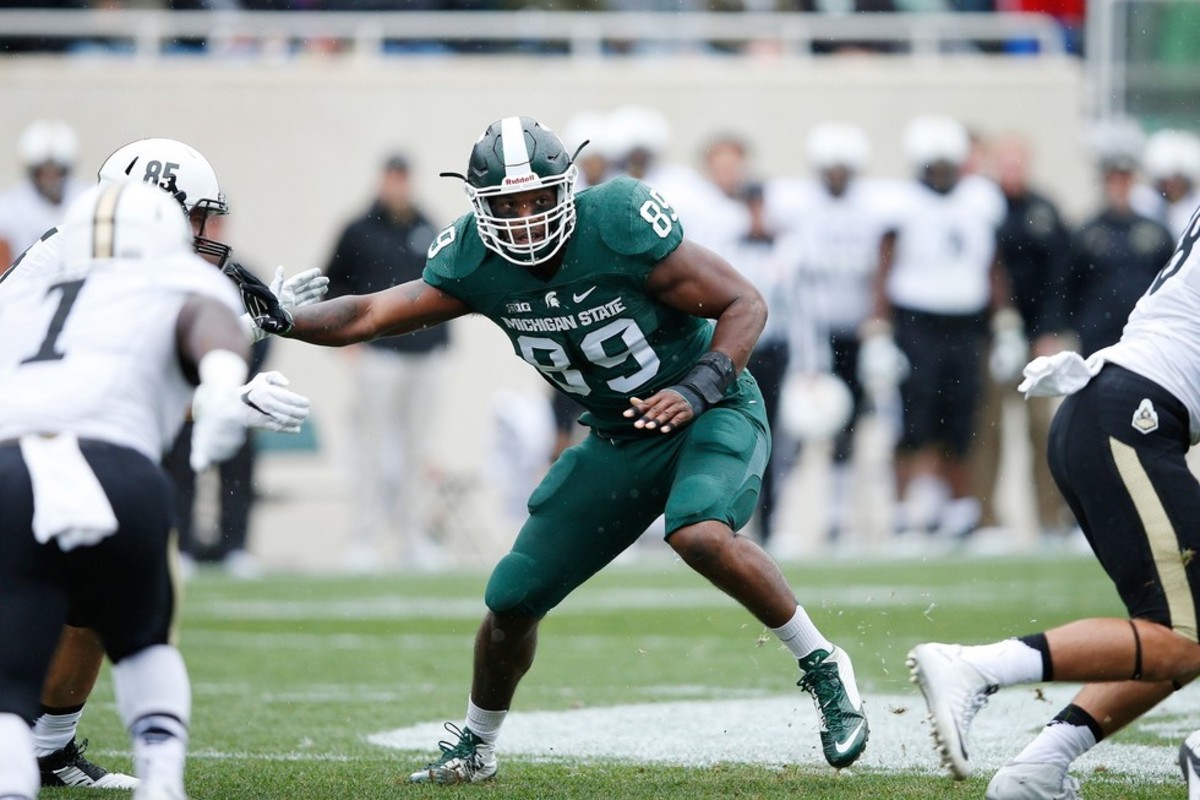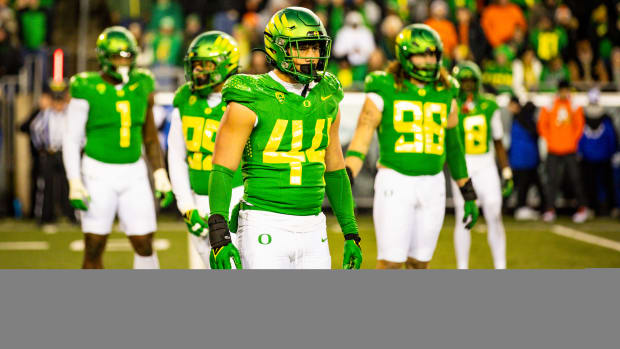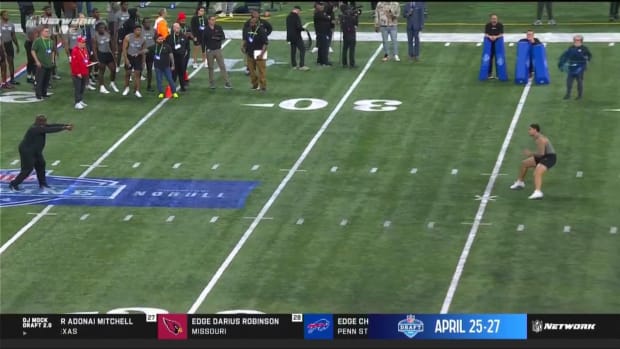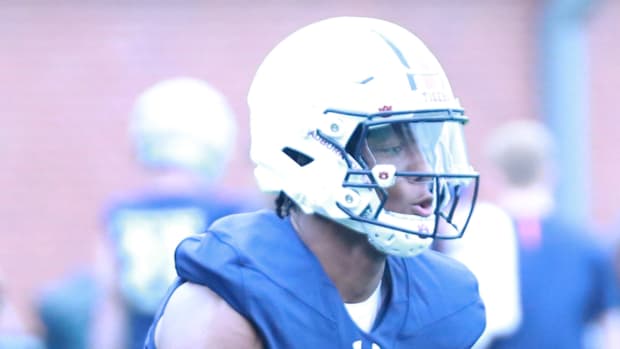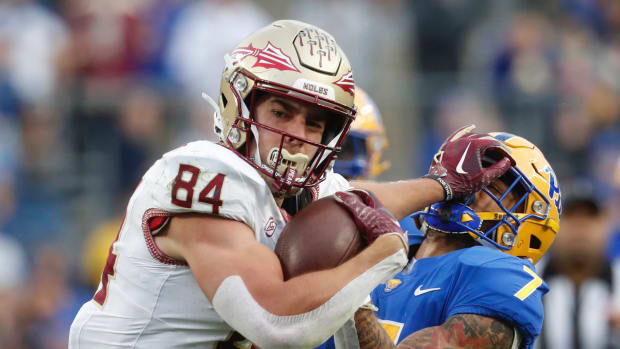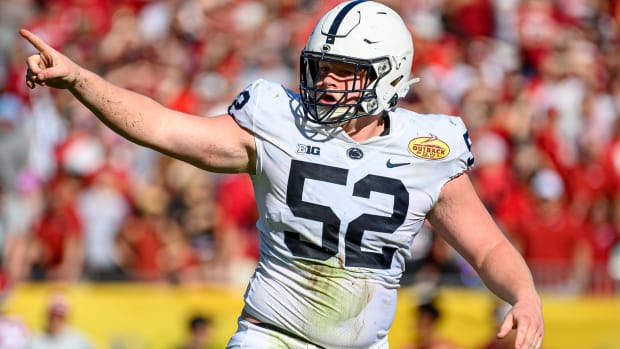Michigan State's secret to success has been finding hidden recruiting gems in the most unlikely places
DALLAS — The unincorporated community of Dry Branch, Ga., has a zip code and not a whole lot else. It's not even the place where the story of Michigan State's greatest recruiting discovery begins. For that, you must travel about an hour south, to a town covering roughly five-and-a-half square miles of land, a slightly larger speck in the middle of the state named Vienna. There, in this nook of 4,000 people, lived a football player named Keith Mumphery. One of Mumphery's mentors, hoping to catch the attention of college programs, sent out film of the wideout in 2009 to various programs. The Spartans' coaching staff got their hands on it—and this is where the story starts.
Michigan State coaches watched the video of Mumphery. They liked what they saw from a 6' 1", 195-pound athlete with good speed. He was a three-star prospect; not bad, but hardly coveted. But this was a staff accustomed to making more out of less. So they followed up with an in-person inspection and subsequently offered him a scholarship. Mumphery verbally committed to the Spartans in early October of his senior year, and when he played his final game for Dooly County High later that season, one of his future coaches, Spartans assistant Dave Warner, was in attendance. The Twiggs County High cornerback who lined up across from Mumphery for a good part of the night was a 5' 11" kid named Darqueze Dennard, a senior with zero scholarship offers.
Warner had not heard much about Dennard. No major college coach anywhere had
seen much of anything, in part because the Twiggs County coach had undergone major knee surgery before the season and failed to send out film as a result. Middle Tennessee State had dropped Dennard from recruiting consideration earlier in the fall. Michigan State had little reason to travel to watch small-town Georgia football and pay attention to Darqueze Dennard.
But then this two-star prospect played well at corner against Dooly County. He caught a touchdown pass. He returned kicks. He piqued Warner's interest. A few weeks later, Dennard's film arrived in East Lansing.
"[Dennard] was electric," Warner says. "He did it all."
He was unvarnished, underdeveloped. But the potential was there.
Four years later, Dennard, a defensive back from the no-stoplight speck on the map named Dry Branch, would be a unanimous first-team All-America for Michigan State, a Jim Thorpe Award winner and a first-round NFL draft pick of the Cincinnati Bengals. There are championship-level programs that enjoy grocery-store recruiting, with coaches selectively plucking the finest, freshest players from the shelves. And there's nothing wrong with that.
It's just amazing what you can find where no one else is looking. "It's what we see," says Brad Salem, Michigan State's quarterbacks coach and recruiting coordinator, "and it doesn't matter what other people see."
*****
Andy Lyons/Getty Images
On one side of the College Football Playoff semifinal at the Cotton Bowl on Thursday there will be Alabama, a behemoth built in the most self-evident way imaginable: From 2011 through '15, the Crimson Tide ranked No. 1 in the national composite recruiting rankings
every single year, their belly distended by four- and five-star signees. On the other side there will be Michigan State, a team built through journeys on far less traveled roads, paths that lead to here-be-dragons spots like Dry Branch, Ga., and Plainwell, Mich., and Georgetown, Ky., and Hinckley, Ohio. The Spartans have found prospects of middling to no acclaim, identified them as possible future stars and been proven correct enough times to win 11 or more games in five of the last six years. Their ability to see what others cannot, and to do so regularly, has them two wins from a national title.
How Alabama has done it is enviable. How Michigan State has done it is near inexplicable.
"That's something we've talked about the last couple of years—not just for this game," Spartans linebacker Riley Bullough says. "We've never really had that many five-star recruits on our team. We pride ourselves on having hard-nosed, tough football players. That's what has gotten us to this point. We want to continue that and show the nation that you can win without top-ranked recruiting classes. Even though it's nice, it's about the people you bring in and how hard they're willing to work."
It should be noted that Michigan State has compiled consecutive top-25 composite recruiting classes that have included a combined nine four- or five-star prospects, and its class of 2016 commitments ranks 15th nationally, with nine composite four-star recruits alone. The more success you have, the less you have to dirty your fingernails flipping over every stone.
But without uncommon talent evaluation, the program doesn't arrive at that point. Before, there were players like Le'Veon Bell, who had a single offer from Bowling Green and then rushed for 3,346 yards for the Spartans in three seasons. Or Kirk Cousins, the current Washington Redskins starter who finished his career as Michigan State's all-time leader in passing touchdowns, yards, completions and efficiency, and whose only other option out of high school was Western Michigan. Or Mumphery, who had 88 catches in four years for the Spartans before becoming a fifth-round pick of the Houston Texans in the 2015 draft. Or two-star recruits like Dennard and Trae Waynes, the latter of whom was most notable for being Melvin Gordon's high school teammate, and who was selected with the No. 11 pick in the 2015 NFL draft.
Now, there is Connor Cook, an All-Big Ten quarterback with 34 wins and 8,984 career passing yards, who was a three-star prospect and who says he didn't know the difference between a Cover 2 and a Cover 4 coming out of Walsh Jesuit High in Cuyahoga Falls, Ohio. There is Jack Conklin, the 6' 6", 325-pound left tackle who may be a first-round draft selection next spring; he was previously a zero-star recruit from Plainwell, Mich., and was headed to a prep school before receiving a late offer from the Spartans to try out as a walk-on. Even Shilique Calhoun, now a three-time All-Big Ten defensive end and the program's all-time leader in tackles-for-loss yardage (267), was a wiry three-star recruit out of Middletown, N.J., who says his knowledge of the game was so remedial that he couldn't have named a single college football stadium as a high school senior.
"To be honest, I probably was terrible," Calhoun says. "I wouldn't have even watched my film if I was them. I'm surprised I'm here. I don't know what they saw."
Ask a Spartans assistant about how they do this, about how they identify and evaluate these less-regarded prospects, and the explanation is similarly elusive. Essentially, they're not sure how to explain what they see, other than to say they know it when they see it.
"You want guys that are willing to work," Salem says. "[And] obviously have an upside athletically. Guys that play with toughness. Guys that seem very coachable. You hope you recruit players who have the capacity for change—meaning, they're not comfortable with where they are. But they're willing to work for everything. And, as we say, they want to earn the jersey. Things are just not given."
More practically, a methodical recruiting process helps Michigan State be right more often than not. Head coach Mark Dantonio and his staff insist on intimate knowledge of a recruit, of gauging his abilities with their own eyes instead of reacting to a film clip or a flurry of offers from other schools. Until Dantonio's assistants make their on-site inspection, be it at a high school or at a summer camp, they won't move forward. This was the case with Waynes, who received an offer after attending Michigan State's one-day senior camp; his high school film was so poorly cut that coaches weren't sure how he made interceptions, but his backpedal and change of direction skills were convincing enough in person to warrant a scholarship offer.
For prospects who have a higher profile, patience permits the Spartans' staff to become reasonably sure that entitlement or attitude issues won't clash with the values of the program. "If a guy is getting recruited by everyone under the sun, we're going to go the same pace," says Warner, Michigan State's co-offensive coordinator and running backs coach. "We're still going to be as thorough as we can."
With unheralded recruits, a deliberate approach may allow coaches to alight on an insight that everyone else was in too much of a hurry to notice. Spartans coaches will take pains to observe a recruit in the weight room at his high school, to determine how hard he pushes himself, to watch how he competes against nothing but his own set of standards.
"Jack Conklin may have only been able to bench 225 pounds four times when he was a senior," says Michigan State offensive line coach Mark Staten, who served as Dantonio's first recruiting coordinator (through 2011). "But he was attacking those four [reps] as hard as he could and straining as hard as he could to get to that fifth one."
There are, of course, benchmarks that every recruit must hit. Standard physical measurements like 40-yard dash times and standing broad jumps offer clues to the Spartans coaches, just like they would for any coaching staff. "You do have to show those for us to show an interest," Salem says. Or, as Staten puts it even more succinctly, "We're not going to take a 5' 5", 120-pounder."
Flexibility on both sides of the recruiting process has provided Michigan State more chances to hit, too. The staff is willing to bring prospects in without a specific position in mind and then shuttle them from one spot to another to fill needs, which reduces the chances of a player getting mired at a position that simply isn't working for them and effectively being categorized as a failure. Dan France was a three-star linebacker and defensive end recruit out of North Royalton, Ohio, and played on the Spartans' defensive line for two seasons before they began to struggle on the other side of the line of scrimmage. Michigan State shifted France to the offensive line and he then started 37 games at tackle or guard between 2011 and '13. He is currently a member of the Cincinnati Bengals' practice squad.
It was likewise a little pliability, and a little good fortune, that brought Bell to Michigan State. Bell was nearly left to take his lone scholarship offer from Bowling Green because, like other teams, the Spartans were satisfied with their tailback stash and weren't sure they needed another one. But Mike Tressel, now Michigan State's co-defensive coordinator, was persistent in recruiting Bell and the staff as a whole couldn't shake the idea that Bell, who went to Groveport (Ohio) Madison High, was one of the top players in his area. Michigan State's coaches resolved that he could help in some capacity, even if it wasn't carrying the ball every down.
"A lot of times, we're not afraid to take guys we know are going to play somewhere," Salem says. "And they make our team better."
From virtually the first carry Bell took in spring practice of 2010 (he arrived as a mid-year enrollee), it was clear precisely how he was destined to make the Spartans better. Bell gained 605 yards as a freshman despite competing for carries with Edwin Baker and Larry Caper.
"He had that drive," Staten says. "It's like a taste in your mouth: For all of you who missed on me, I will make you pay. That's what Le'Veon brought to every game."
And, really, this may be why Michigan State has had success looking where few other major programs bother to look. The staff calculates how long and hard a high school prospect is willing to work to prove people wrong—although yes, admittedly, that's a fairly unquantifiable ability. But the record suggests the Spartans coaches are skilled in this way; if it were pure providence, it wouldn't keep happening. If it were sheer luck, Le'Veon Bell and Darqueze Dennard and Shilique Calhoun and Jack Conklin would be the exception, not the rule.
It's instructive to hear Calhoun, now a 6' 5", 250-pound annihilator of quarterbacks, recall the inception of his relationship with Michigan State. He was, as he says now, fairly oblivious to football. He says he didn't know what a 3–4 or a 4–3 was.
"When I was in high school, they lined me up and said, 'Get the guy in the backfield,'" Calhoun says.
When Pittsburgh head coach Pat Narduzzi, who was then the Spartans' defensive coordinator, visited Middletown North High, he heard all about this. It was another on-site inspection of a prospect with few offers—Rutgers was the most serious competition—and Narduzzi listened to a straight-shooting review about how raw Calhoun was, about how he was more of a basketball fan than a football nut, about how Calhoun couldn't name any football stadium except maybe Giants Stadium, and only then because it was about 40 miles up the New Jersey Turnpike. All that was true. There was just one addendum that Calhoun recalled his high school coach, Joe Trezza, making to the man who would decide that this unfinished prospect with a bunch of offers from mid-tier, East Coast programs belonged at Michigan State.
"What he will do," Trezza said, "is work hard."
*****
Streeter Lecka/Getty Images
In a hotel conference room on Sunday morning, the interview representatives from the Spartans' defense were, well, representative: linebacker Darien Harris, a former three-star recruit, the same as linemen Joel Heath, Bullough and Calhoun. They and others like them have been the propellant for how the program got into the playoff, but in not too long they'll give way to more heralded prospects, more credentialed recruits. And the question will be whether the operating principles of the program will give way, too.
"That's why they've had success at Michigan State, that's the mentality that they have there—everybody goes to work, it doesn't matter who you are," Narduzzi says on the phone from his office in the Pittsburgh football facilities. "You could be the best player in the country—you better do your job and practice or you ain't going to make it."
If this is true, then maybe it's best that the Spartans continue to pursue the small names in the small towns, to cast their eyes toward the places no one else cares to consider.
It would be foolish, naturally, to resist the recruiting spoils of their success. If Michigan State can compete for the nation's top talent, of course it should. And if its coaches adhere to the meticulous, disciplined prospect evaluation that has served them well so far, then they might well identify those top-shelf prospects that still want to work, the ones that arrive in East Lansing without their skulls swollen with acclaim.
But just in case, in the event that years of being told how good he is numbs a top prospect's capacity to strive for something more, it would be helpful to point to a guy in the room who is under no such delusion. A guy who arrived with no fanfare, who was ignored and overlooked, and who walks through the door aggrieved every day.
"That hunger, that desire," Staten says, "it'll bring two or three other guys with him."
And they're there already as the program prepares to play for a national title. Grayson Miller was a three-star safety for Scott High in Georgetown, Ky. He had one other reported college scholarship offer, from Western Kentucky. Perhaps schools knew he craved a Michigan State offer since his father, John, was an All-Big Ten safety for the Spartans in 1987 and '88. Perhaps his commitment in the summer before his senior year precluded any other big-conference programs from showing interest. Then again, they weren't stuffing Miller's mailbox with offers before he arrived at Michigan State's camp in 2014 and ran well enough and demonstrated enough ball skills to earn a scholarship offer.
Then this three-star recruit played in 11 games as a true freshman (starting four) for the Big Ten champions. In the recruiting race to find players who can help in any way, almost no one else was looking at Miller. But Michigan State's coaches saw what they needed to see, and they figured they had a good idea about what would come next.
